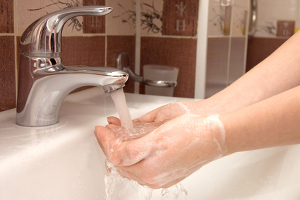Choosing Plumbing Fixtures in The Colony

Your plumbing fixtures in The Colony are among the hardest-working items in your business. Fortunately, there are many suggestions to assist you in choosing them. The Uniform Plumbing Code sets fixture needs for the public area of your restaurant, primarily the restrooms.
For the kitchen, and food preparation in general, NSF International (formerly the National Sanitation Foundation) has extensive guidelines. Here are some points to think about when selecting your plumbing fixtures and designing your restrooms.
Water Closet: Yes, that’s the fancy name for “toilet.” It ought to be made of solid, glazed porcelain, having a flush tank that discharges water when a lever or button is pushed. Another way to flush the tank is with pressure valves; nevertheless, they use a lot more water.
The toilet in The Colony ought to have a self-closing lid; some have no lids at all. You will find plenty of ways to save water in the restrooms. Dual-flush-option toilets, utilized in Europe and Asia for more than a decade, let customers use as little as 0.8 gallons per flush, or 1.6 gallons, depending on need.
Pressure-assist toilets use a stress vessel inside the tank to create a combination of drinking water line pressure and compressed air to flush. Any commode that uses less than 1.28 gallons each flush is considered a high-efficiency toilet (HET); today’s legal standard for new construction is 1.6 gallons per flush, but there are lots of, older facilities that still use the “old-fashioned” toilets with 3.five gallons or more each flush.
Your city’s plumbing code specifies the number of toilets and urinals you must have for your restaurant; some cities require more should you serve alcoholic beverages. The general rule is two toilets for every 150 female guests and two urinals for every 150 male guests.
Urinal: This companion fixture for men’s restrooms should also be solid, glazed porcelain. You will find stall, wall, and pedestal-style installations; the wall-mounted urinal is the greatest, simply because it makes cleaning easier beneath the urinal. The flush valve is the most common mode for flushing urinals.
Lavatory: The lavatory is also called a hand sink. The preferred material for this essential part of every restroom is, again, glazed porcelain. The hand sink is needed in most cities to supply both hot and cold drinking water, having a common mixing faucet for temperature control.
Aerators are a must for your restroom sinks; these simple attachments to the faucet head will decrease water flow from 1.five gallons each minute (gpm) to 0.5 gpm. On average, they will save about $268 each sink, per year, without compromising water pressure. The sink should have an overflow drain. Other wellness code requirements consist of soap dispensers (not bar soap) and disposable towels for hand drying.
Although heater-blowers can dry hands with warm air, they are not particularly energy efficient. For every 100 guests, you’ll need to provide 1 hand sink in every restroom. You have to be certain that at least one sink is installed such that a person in a wheelchair can use it, to meet the guidelines of the Americans with Disabilities Act. We’ll discuss hand sinks in the kitchens in just a moment.
Other Considerations:
Usually, it is advisable to have 1 floor drain in each restroom stall and at least 1 within the urinal region from the men’s room. If the restrooms are big, consider installing additional floor drains to make mopping simpler as well as to catch any potential plumbing overflows. A working exhaust fan might be needed by the local health code.
Even if it’s not, it is a good idea, to circulate the restroom air. Install spring-loaded doors on restrooms to prevent people from leaving them open. Finally, another crucial consideration: Restrooms should meet both local and federal needs of accessibility for physically disabled guests. At the back from the house, the plumbing fixtures should withstand heat, grease, heavy-duty cleaning products, and all the rigors of cooking.
They consist of sinks and drains, discharge systems, venting systems, and hot-water tanks. As a rule, the architectural drawings of the building will consist of plumbing, electrical, and mechanical connections: Ask that the drawings be rendered in 1/4-inch scale, and include a schedule of equipment to be plumbed.